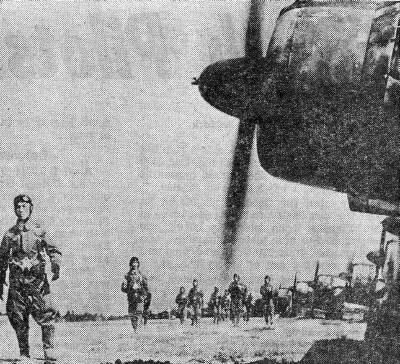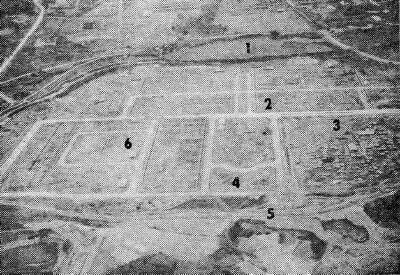ITAZUKE SONICLE
March 6, 1964
Zeros Once Operated From Itazuke
Known As Mushiroda,
Air Base Built in 1944
 Itazuke's flight line looked like this in 1944 when the
6th Wing
Itazuke's flight line looked like this in 1944 when the
6th Wing
of the Japanese Air Force flew fighters and reconnaissance
aircraft from the base's 3,500 foot runway.
The roar of aircraft engines will be silent at Itazuke for the first
time in 20 years this summer when the 8th Tactical Fighter Wing moves
to Yokota Air Base.
Construction of Itazuke Air Base, Kyushu's largest and most active
airfield, was begun in late 1943 by the Japanese Army Air Force. Known
to the Japanese as Mushiroda, the air strip was completed in late 1944
and had a north-south main runway approximately 3,300 feet long and 300
feet wide, plus a short supplementary northeast-southwest runway.
Mushiroda, or Itazuke, was built on farmland that once grew bumper rice
crops. The base was first used by trainer aircraft. The strip soon
proved unserviceable for the fledgling flyers because of the high water
level of the former rice lands. Frequent rain showers flooded the
runway making it unsafe for the novice aviators.
Early Mission
The Japanese Air Force's 6th Fighter Wing replaced the trainers and
Mushiroda became an air defense base. The 6th Wing had 30 single engine
fighters and several reconnaissance aircraft to patrol the
Okinawa-Kyushu aerial invasion corridor.
In April of 1945 the Tachiarai Airfield at Kurume was destroyed by
American B-29's. Tachiarai's bomber aircraft were moved to Mushiroda
and the base became very active until late in the war when B-29's dealt
a death blow to the Japanese forces stationed here.
Zasshonokuma Aircraft
Hub
During the war the village of Zasshonokuma had an industry called the
Watanabe Iron Works [April
1945 aerial photo] which manufactured aircraft parts. Late in
the war the company was renamed the Kyushu Airplane Company and
equipped to make complete aircraft. The factory was assigned a monthly
quota of 300 planes.
The Kyushu Airplane Company experimented with a radical long range
fighter called the J-7. The J-7 sported a rear mounted propeller and
was supposedly capable of making sustained passes at the dreaded B-29.
The new interceptor was test flown at Itazuke on August 3, 1945 in the
presence of Prince Mikasa. Evidently the rear engined craft did not
live up to its designed expectations. Japanese who lived in Fukuoka
during the war remember frequent crashes of the J-7.
The Kyushu Airplane Company is presently known as Camp Fukuoka -- home
of the Japanese Ground Self Defense Force's 4th Division.
First Americans
In October of 1945 American occupation forces arrived in Fukuoka. Lt.
Col. McBride from the Army Engineers was the first American to arrive
at Itazuke. He landed at Sasebo and drove a jeep to Fukuoka and took
command from a Japanese Major in the Administration Annex building that
now houses the JASDF Western Air Defense Sector headquarters.
When McBride arrived the only portion of the Annex in existence was the
Kasuga Courts, motorpool, and BX Garage areas. The balance of the Annex
was farmland.
During the war the Annex was called the Kasugabaru Branch of the Kokura
Army Ordnance Depot and was a munitions arsenal. When Lt. Col. McBride
visited the Strip he saw a wasteland. The runway was marked with bomb
craters. The only building to survive the B-29 onslaught was a triple
hangar.
Col. Hugh A. Parker (now a retired major general) was the first base
commander of the Itazuke Complex. Parker's military holdings consisted
of the small Annex (Base 1), Camp Fukuoka (Base 2) and the Air Base.
Camp Fukuoka, the old Kyushu Airplane Company, had escaped wartime
destruction.
Parker served three years at Itazuke. During his tenure he established
good rapport with the Japanese and inaugurated a massive construction
program. When Parker left, a grateful Japanese contractor built statues
of Parker and Lt. Col. McBride. The statues still stand in a formal
garden near the Kasugabaru commuter station.
315th Wing Here
The 315th Composite Wing, the first air unit assigned to Itazuke,
arrived in late 1945. The Wing flew F-51 Mustangs. The only available
buildings to house the Wing's people was the Kyushu Airplane Company's
complex in Zasshonokuma. Designated Base Two, the aircraft company was
converted to barracks, dining halls, a post exchange, and BOQ.
Additional facilities and billets were housed in a tent city at the Air
Base.
Land was available at Base One (Annex) and expansion was planned to
alleviate the congested living areas at Camp Two and the Air Base.
 This is how the Annex looked in 1946 when the Army
Engineering
This is how the Annex looked in 1946 when the Army
Engineering
Corps expanded the base. The rice paddy (No. 1) is now a housing area;
(No. 2) library; (No. 3) BX; (No. 4) Group headquarters; (No. 5)
chapel, and (No. 6) is now the Officers' Club.
First Dependents
Dependent travel was authorized to Itazuke in August of 1946. There was
no base housing and families lived in Japanese houses. Only field grade
officers were allowed to move their families to Japan. There were about
thirty families here by Christmas, 1946.
When the Air Force moved here, the Japanese National Railway tracks
were the western boundaries of the sleepy rural villages of Kasugabaru
and Shirakibaru.
Route 3 -- the highway that connects the Annex with the Air Base -- was
a dirt road until 1948. The conversion rate of Yen to MPC was 15 to 1
and the 100 Yen note was the largest Japanese currency in circulation.
In late 1945, the Air Force opened a radio station, WLKI, later
affiliated with FEN. Resort hotels at Unzen National Park and Mt. Aso
were reserved for Americans.
[SPECIAL PAGES: Far East Network Kyushu (FEN Itazuke)]
In 1949, a ten acre base farm was established and produced 35 tons of
fresh vegetables during its first year. The produce production covered
everything from strawberries to corn. Poultry was a sideline of the
farm officer. Despite aircraft noise, the chickens layed an average of
1,500 eggs per day in 1949.
Major construction for enlarging the Annex was started in 1946 and
completed in 1947. Most of the buildings south of the river that once
divided troop housing and dependent housing were constructed during
this period. The present 700 housing area was once a hilly orange grove.
The dependent school was started in January of 1947. The student body
was 11 boys and 4 girls with two dependent wives as faculty.
In March of 1949, the 8th Fighter-Bomber Wing returned from Ashiya and
replaced the 315th Composite Wing. The 8th was flying the F-51 Mustang
but started converting to jet F-80 Shooting Stars in December.
The dependent housing area behind Group Headquarters was built in 1950.
The swimming pool opened the following year.
Camp Fukuoka (Base Two) was returned to the Japanese when permanent
facilities were completed at the Annex.
Korea
Unknown to most Americans, Itazuke played a key role in the Korean War
and the defense of the Pusan perimeter in 1950.
The announcement of the violation of South Korean territory on June 25,
1950, was a signal for mass evacuation of U.S. civilians from the
troubled Republic.
The 68th Fighter Interceptor Sq. provided aerial cover for both the
Norwegian freighter Heinholdt, evacuating Americans from Inchon, and
Air Force transports that were airlifting diplomatic representatives
from Seoul.
The evacuees were sped to Itazuke where they received their first food
in many hours.
On June 27, American air units were ordered into action against the
invading Communists. Itazuke's proximity to Pusan made the base the
center of all air operations in Korea. At one time there were four
tactical wings flying sorties from Itazuke.
The 8th Wing moved to Korea in late Fall of 1950. With the move the
support element that remained here was redesignated the 6160th Air Base
Wing.
In 1954 the Eighth returned to Fukuoka. The base settled down to
another era of peace to become the key base in the defense of Western
Japan.
Related
article:
http://www.usc.edu/libraries/archives/dsjp/summaries/1999/April/Sm990430.htm
TOKYO SHIMBUN (Page 27) (Abridged)
April 27, 1999
On the evening of March 26, a U.S. Air Force C-141 transport plane
landed at Fukuoka Airport. It was on a training mission to
airlift U.S. military personnel's families from South Korea in
anticipation of a crisis on the Korean peninsula. The mission
had two meanings. For one thing, U.S. forces used a Japanese
civilian airport for the first time in carrying out this kind of
training. For another, Fukuoka Airport was on the list of
private-sector facilities informally requested by the U.S. government
for the U.S. military's use in the event of regional contingencies.
Fukuoka Airport used to be the U.S. Forces Japan's Itazuke airbase
before its 1972 reversion. Itazuke was one of the USFJ bases
for attack operations in the Korean War that broke out in June
1950. Four days after the outbreak of the Korean War, the
local airbase and its environs were alarmed with "unidentified
airplanes" approaching Japan's airspace. It was the first
air-raid alert there in five years after Japan's defeat in the
[Pacific] War, and the Fukuoka prefectural government conducted even an
anti-air raid drill in anticipation of an aerial attack on the locality.
"I don't want to see such a scene—never again. And, I don't
want GIs to come over here any more," says Yutaka Ishinoda, a
79-year-old resident of Onojo City in Fukuoka Prefecture.
Ishinoda was a locally hired security guard with the Itazuke base in
and after 1951—the year after the Korean War broke out. There
were some ammunition depots on the hills situated southeast of the
runway, and one of those storage areas was off-limits to even American
soldiers. Ishinoda says, "I know GIs who used to guard there,
and I often heard them talking about 'Fatman' (i.e., an atomic bomb of
the Nagasaki type). One of my colleagues also saw large bombs
looking like the Fatman. Those bombs were carried on a
trailer into the base late at night." Ishinoda has also seen
casualties being carried in. He recalls, "They were carried
over here in a large transport plane, and always arrived late at
night. The base area used to be thrown into an uproar with
the red lights of ambulances and other lights crossing across the night
sky." In the occupation days, the city of Fukuoka and its
neighborhood were compelled to serve in "rear support" of a United
Nations force.
<><><>
In 1998, U.S. warplanes made 162 flights in total to Fukuoka Airport
under the Japan-U.S. Status of Forces Agreement (SOFA) and 309 flights
to Nagasaki Airport. The U.S. military has usually made use
of Nagasaki Airport to carry personnel to the Sasebo base in the
prefecture of Nagasaki, and Fukuoka Airport to transport supplies.
Chujiro Matsumoto, a 63-year-old local citizen, retired from a major
airline company in the spring of 1996. He has now joined a
pacifist group in Fukuoka City and has since been watching Fukuoka
Airport. He says, "There have been conspicuous moves in
anticipation of the guidelines." In February, the USS John S.
McCain, an Aegis destroyer home-ported at the U.S. naval base in
Yokosuka, entered port at Hakata. The municipal government of
Fukuoka City first rejected the battleship's port call, reasoning that
the port would be crowded with many merchant ships. But the
city later admitted the U.S. naval vessel into port for five days as
desired by the U.S. Navy.
"Fukuoka has port-harbor facilities as well as airport, and also has
medical institutions and amusement quarters. I think this is
probably the right location for the U.S. military's scenario to deal
with a possible emergency on the Korean peninsula. U.S.
forces would make use of this location for their convenience to make in
into a fait accompli." With this in mind, Matsumoto is
worried about the possibility of his locality being gradually turned
into a military base.
|